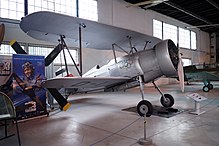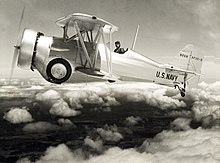Curtiss F11C
| Curtiss F11C | |
|---|---|
 XF11C-2 Goshawk in 1932 |
|
| Type: | carrier-based fighter |
| Design country: | |
| Manufacturer: |
Curtiss Airplane and Motor Company |
| First flight: |
September 1932 |
| Number of pieces: |
> 290 |
The Curtiss F11C Goshawk was a carrier-based dive combat and fighter aircraft made by the American manufacturer Curtiss Airplane and Motor Company in the 1930s.
history
On April 16, 1932, the United States Navy ordered two prototypes of a new carrier fighter aircraft under the designations XF11C-1 and XF11C-2. The XF11C-1, delivered in September 1932, used the wings of the YP-23 . On October 18, 1932, the US Navy placed an order for 28 F11C-2s, the delivery of which began in February 1933 and was completed in May of that year.
The fourth aircraft of the lot was equipped with a manually retractable landing gear and was first given the designation XF11C-3, which was changed to XBFC-3 in March 1934. At the same time, the F11C-2 were given the new designation BFC-2.
construction
The F11C-1 was a metal construction with covered fuselage and tail surfaces and a Wright R- 1510-98 600 hp two-row radial engine. In contrast, the F11C-2 used a composite construction, whereby the wooden wings were covered with fabric. The fuselage structure corresponded to that of the F11C-1. The single-row radial engine Wright R- 1820-78 with an output of 700 hp served as the engine.
variants
Variants and production numbers according to John Andrade p. 183 and p. 186. The mission code “BF” for “bomber fighter” was only used from 1934 to 1937. Except for the BFC and BF2C, it was only used for the Boeing BFB . See also mission IDs of the US Navy from 1922 to 1962
- XF11C-1, from March 1934 XBFC-1 (Model 64)
- A machine was built (BuNo 9219 or 9217), which was used by the NACA from mid-1934 to test engine cladding. Retired in March 1939 after only 319.4 Navy flight hours.
- XF11C-2, became XBFC-2 (Model 64A)
- A machine built was used as a dive combat demonstration aircraft for Curtiss (BuNo 9213). When dropped in a dive, the 500 lb bomb was pivoted so that the propeller could not be hit. Smaller bombs could be carried under the wings. The machine crashed in August 1932 after 74 hours of flight.
- F11C-2, became BFC-2
- Production model, 28 units built, delivered from March 1934 and used with the VF-1B (later renamed VB-2B and finally VB-3, from January 1938 on the USS Enterprise with VB-6) until December 1938. The cost for the airframe was US $ 13,000 and the R-1820 engine was US $ 6,242. With the renaming to BFC-2, modifications were made that were carried out on site during the deployment. This included a new, raised cover for the rear fuselage together with a new hood that now half covered the previously open cockpit.
- XF11C-3, became F11C-3 and then XBF2C (Model 67)
- One copy built (BuNo 9269)
export
- Hawk I
- The only difference to the Hawk II was the smaller fuel tank, 10 copies were built
- Hawk Ia
- 4 built, including the Gulfhawk I (NR982V) for Gulf Oil
- Hawk II (Model 65)
- based on the XF11C-2: 126 machines built, Bolivia (9), Chile (3), China (50), Colombia (26), Cuba (4), Germany (2), Norway (1), Thailand (12) , Turkey (19)
- Hawk III
- was based on the BF2C-1, built 136
- Hawk IV (Model 79)
- 1 machine built with the civil registration number NR188M.
Udets dive fighters

Ernst Udet received the two machines exported to Germany at the beginning of 1934 , which he used for his tests on suitability as dive fighter aircraft and for aerobatic demonstrations. The planes had civil registration plates . The machine, initially approved as D-3165, was given the new D-IRIS designation towards the end of 1934 after the system changeover. She crashed on June 20, 1934 while trying to fly over the Tempelhof airfield , whereby Udet was able to save himself with the parachute. The second machine, which Udet then used at many demonstrations, was registered as D-IRIK, with the Olympic rings being painted on the fuselage at times to advertise the 1936 Summer Olympics in Berlin . Towards the end of the war, parts of the German Aviation Collection were relocated to Poland, including D-IRIK. There are two other aircraft around the world, a Hawk III in the Royal Thai Air Force Museum and a BFC-2 in the National Museum of Naval Aviation in NAS Pensacola (Florida, USA).
Technical specifications
| Parameter | F11C-2 | Hawk I / II |
|---|---|---|
| crew | 1 | 1 |
| length | 7.62 m | 8.08 m |
| span | 9.60 m | 9.60 m |
| height | 3.23 m | 2.97 m |
| Wing area | 24.34 m² | 24.34 m² |
| Empty mass | 1378 kg | 1317 kg |
| Takeoff mass | 1869 kg | 1758 kg |
| Top speed | 330 km / h | 301 km / h |
| Ascent time (at 1525 m) | 2.6 min | k. A. |
| Range | 901 km | 666 km |
| Engines | a Wright R-1820 -78 Cyclone with 700 PS (515 kW) |
a Wright R-1820F-3 Cyclone with 710 PS (522 kW), 356 l of fuel / Hawk I: 236 l |
See also
literature
- Fighter A to Z , in AIR International, July 1976, p. 48 f.
- John M. Andrade: US Military Aircraft Designations and Serials , Midland Counties Publ., 1979
- Curtiss Navy Hawks in action , Aircraft Number 156, squadron / signal publications, 1995, ISBN 0-89747-342-6
Web links
- Photos of the F11C-2 from different periods
- Short history at aviastar.org, text is 1: 1 from AIR International, July 1976
Individual evidence
- ^ John M. Andrade: US Military Aircraft Designations and Serials
- ^ Curtiss Navy Hawks, p. 34
- ↑ To Udet's crash on the website of the Polish Aviation Museum
